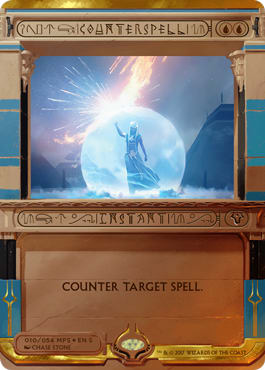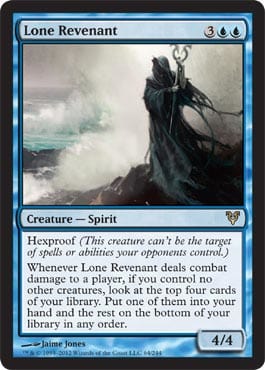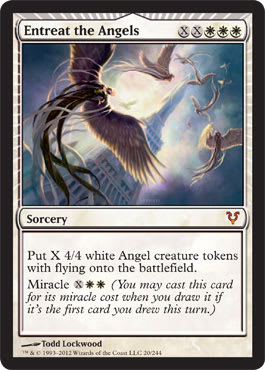So, I played Junk Walkers at StarCityGames Open Providence and did not do very well. I played that because I managed to convince myself not to heed the lessons I’ve learned over many years of playing Magic. See, as far as I’m concerned, this is a lesson I learned a while back, and I forgot it for this event:
If that was all this was about, this subject wouldn’t be worth writing about, but what’s important is how I made it to where I was: I didn’t trust my own knowledge of myself. This is among the most important things to being successful both as a player and in life in general. Knowing who you are and trusting your own knowledge of yourself allows you to make decisions that play to your strengths and place yourself in the best position to succeed. It’s a lesson I’ve learned before, but apparently forgot it, and I needed to learn again.
Self-Examination
The more I observe this game, the more I am of the belief that there are many differing play styles and that success correlates directly to playing a deck that plays to your strengths while covering your weaknesses. So, where do play styles come from? Why do certain players gravitate toward certain decks?
I believe this phenomenon results from differing approaches to the game. As you learn to play Magic, you develop habits and patterns of thought that coalesce into an approach to the game overall. People think about the game differently, and differing thought processes ultimately results in differing natural play processes. Players thus gravitate toward the archetypes and strategies that feel the most natural—the archetypes and strategies that most often mesh with their own natural ideas, approaches, and thought processes. To be a good Magic player, you obviously have to incorporate ideas from a variety of approaches, but that doesn’t change the fact that you have a default mode.
I believe there are two fundamental approaches to Magic.
Approach 1 – Magic Is a Game of Time
Players who see Magic as a game of time subscribe to the fundamental principle that you just have to win before your opponent does. The end goal of every interaction is to produce a winning board state before your opponent can. In essence, Magic can be viewed as a race, and every action you take is either an accelerant for you or a hindrance for your opponent. Players who subscribe to this approach are drawn to strong proactive strategies such as Wolf Run Ramp and W/U Delver.
Approach 2 – Magic Is a Game of Resources
Players who subscribe to this approach believe that Magic is a game of resource trading and resource management. They see the game as a complicated ledger of sorts—add some resources here, subtract some resources there, and eventually, someone comes out the winner. Players who subscribe to this approach believe that as long as they focus on making beneficial resource trades, the winning-the-game part will take care of itself. Eventually, they will be able to exhaust their opponents of relevant resources, and the act of actually taking the game down will become relatively academic. Players who subscribe to this approach are drawn to strong reactive strategies, generally favoring playing control.
Finding a Preference
Like all things, players express differing degrees of preference for each of these approaches. Some players—such as Paul Reitzl and Gabriel Nassif—exhibit strong preferences for specific archetypes, probably due to their own preferences and way they approach the game. However, there are also players such as Jon Finkel who play a variety of decks and see success with a variety of strategies, only exhibiting a mild personal preference, if any at all. Understanding where on this spectrum you lie is important to your future success. But why?
Magic tournaments can be long, grueling endeavors. Both preparing for them and playing in them require a significant investment in both time and energy. As players, you have a limited amount of energy to devote at any given time, and making the most of your own energy is important to success. Playing a deck you are comfortable with means that you spend less time thinking and more time acting instinctively, thus conserving energy. Familiarity and comfort with archetypes and decks can be gained through practice, but if you gravitate toward a specific strategy or archetype, natural familiarity is something that shouldn’t be overlooked.
So, what does that mean for an individual player? Well, let’s see. I’ll use myself as an example.
I gravitate toward two types of decks: extremely strong, proactive strategies designed to force do-you-have-it moments and highly defensive strategies equipped to run a war of exhaustion on all fronts. In other words, I gravitate toward the two extremes of the strategic spectrum, highly aggressive decks and extremely controlling ones. In “Who’s the Beatdown?” terms, I want to know my role in every matchup. I either want to always be the beatdown or always be the control.
The second thing that I know is that as I’ve developed as a player, I enjoy playing beatdown less and less. As I became better at doing “red deck math,” I realized that often, there was a ton of ways of playing out of the situations aggro players would put you in. Defensive cards such as Day of Judgment, Path to Exile, Condemn, and Timely Reinforcements often put the aggressive player in an unwinnable position, caught between powerful answers. Thus, for the most part, I have put down the highly aggressive and proactive decks, with the exception of fast combo (pretty much the only reason I would play Legacy at this point).
This means that as far as I’m concerned, I should basically just play the blue deck in every format. My own natural inclination is to play hyper-defensively in pretty much every situation, and I tend to feel awkward when I am forced to make attack-or-hold-back decisions. I almost invariably lean to the side of holding back, which means that I am best at playing decks with strong end games that lead toward inevitability.
Knowing me, this is what I should have played at the SCG Open and what I will probably play in the upcoming Standard format:
"Avacyn Restored Esper Control"
- Creatures (6)
- 3 Phantasmal Image
- 3 Sun Titan
- Planeswalkers (5)
- 2 Gideon Jura
- 3 Tamiyo, the Moon Sage
- Spells (23)
- 1 Go for the Throat
- 2 Doom Blade
- 3 Forbidden Alchemy
- 3 Tragic Slip
- 4 Think Twice
- 2 Day of Judgment
- 2 Terminus
- 4 Lingering Souls
- 2 Ratchet Bomb
- Lands (27)
- 1 Swamp
- 3 Island
- 3 Plains
- 2 Evolving Wilds
- 3 Ghost Quarter
- 3 Isolated Chapel
- 4 Drowned Catacomb
- 4 Glacial Fortress
- 4 Seachrome Coast
- Sideboard (15)
- 4 Negate
- 2 Curse of Death's Hold
- 1 Terminus
- 2 Revoke Existence
- 2 Timely Reinforcements
- 2 Oblivion Ring
- 2 Nihil Spellbomb
Building the Deck
I put that list together on Friday night after coming back from FNM and experimenting with an Esper Control list based on Entreat the Angels. I debated running it for a while due to the fact that the list looked solid from all the testing we’d done, and it was a list I would definitely feel more comfortable playing than the Junk ’Walkers list I ended up playing. I knew I’d be more comfortable because this sort of deck suits my natural play style much better.
So, how’d I arrive at this list? I came to it through the fact that Solar Flare seemed to be the strongest Constructed strategy. Despite this being the case, I never really got around to building Flare due to simply running out of time playing with the new toys in Avacyn Restored. I knew theoretically that Solar Flare was probably the right space for a control deck to be right now, but I didn’t test it. I did, however, talk to a number of players whom I trust at FNM, and they all had tested Solar Flare, agreeing that it was actually good. I then took a look at their decks and lists online and decided on the following things based on my conversations, testing, and previous experience with the deck:
- Sun Titan and Phantasmal Image is back in vogue.
- Liliana of the Veil, while good, isn’t worth the strain on the mana.
- Unburial Rites and Snapcaster Mage are good value, but they can be replaced.
- Terminus is good.
- Tamiyo, the Moon Sage is nuts.
- Tamiyo, the Moon Sage necessitates Gideon Jura.
Thus, having learned my lesson, I will be playing Esper in the upcoming format because it is the deck that suits my play style the most. I also have an updated list that features Entreat the Angels—I do want to try the card out a bit more. It definitely had its moments at FNM, but I’m not entirely sure where it fits. This is what I will be trying for now:
"Entreat the Angels Esper Control"
- Creatures (6)
- 2 Phantasmal Image
- 3 Sun Titan
- 1 Wurmcoil Engine
- Planeswalkers (5)
- 2 Gideon Jura
- 3 Tamiyo, the Moon Sage
- Spells (23)
- 1 Tragic Slip
- 2 Forbidden Alchemy
- 3 Doom Blade
- 3 Think Twice
- 2 Day of Judgment
- 2 Ponder
- 2 Terminus
- 4 Lingering Souls
- 2 Dead Weight
- 2 Ratchet Bomb
- Lands (27)
- 1 Swamp
- 3 Island
- 3 Plains
- 2 Evolving Wilds
- 3 Ghost Quarter
- 3 Isolated Chapel
- 4 Drowned Catacomb
- 4 Glacial Fortress
- 4 Seachrome Coast
- Sideboard (15)
- 3 Negate
- 2 Curse of Death's Hold
- 1 Terminus
- 2 Nihil Spellbomb
- 2 Timely Reinforcements
- 1 Revoke Existence
- 2 Oblivion Ring
- 2 Entreat the Angels
Finishing Up
Anyway, I learned again over the course of the SCG weekend that taking your own natural play style into account is extremely important in deck selection. I’d learned that lesson before, but apparently I’d forgotten it, and a refresher was required. Well, it definitely came through loud and clear.
Also, as a bonus, I hope to be able to set up Camtasia soon and start putting up videos. I will be doing them in the vein of this column—as a learning experience. Thus, you won’t see me playing decks such as Esper online. You’ll see me do things such as Cube Draft and playing decks I’ve never touched before. The intention is to lose and to make mistakes, but to show my losing and go over my mistakes in a detailed manner. Magic is a game of constant improvement, and thus, I hope to be able to do video analysis of both my games and potentially professional games as well.
Chingsung Chang
Conelead most everywhere and on MTGO
Khan32k5 at gmail dot com





























